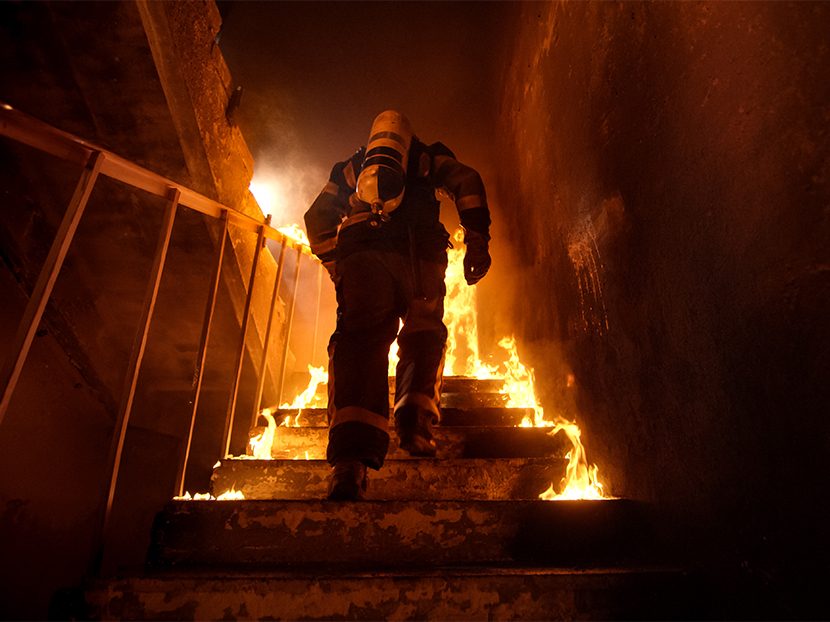Ordinance 18-14: Safety Gaps
Honolulu’s first retrofit fire safety legislation for high-rise apartments leaves room for tragedy.

After the July 14, 2017 fire at the Marco Polo Condominium in Honolulu, a fire resulting in four fatalities and more than $100 million in property damage, the Honolulu City Council reconvened the Residential Fire Safety Advisory Committee (RFSAC). The purpose of the committee was to prepare a report for the council with recommendations for addressing the fire safety of existing high-rise residential condominiums. The RFSAC held its first meeting on Sept. 8, 2017 issued its final report on Nov. 8, 2017.
The RFSAC presented recommendations in following areas:
- A mandate for all existing residential high-rise buildings to be provided with sprinkler protection throughout.
- Buildings with certain features could be exempt from the sprinkler requirements.
- All existing residential high-rise buildings currently not provided with sprinkler protection must undergo a fire safety evaluation, using an AHJ approved fire and life safety risk assessment method and implement improvements needed to achieve a passing score on the assessment.
- Financial incentives to providing fire sprinkler protection.
- Cost reduction measures related to relaxation of certain building code requirements pertaining to sprinkler systems.
Sprinkler Exceptions. Regarding the sprinkler mandate there are two categories of existing residential high-rise buildings that can be exempted from the sprinkler requirement: 1) any building less than 10 stories in height; and 2) buildings of any height that have exterior egress balconies and no interior corridors.
This exemption is significant as it applies to approximately half of the estimated 300 unsprinklered residential high-rise buildings in Honolulu. The RFSAC was clear that these exceptions should not lead one to believe that the RFSAC considers these building features to provide an equivalent level of life safety to residents and firefighters as sprinklers. The committee felt that the threat to very tall buildings with interior corridor systems was significantly greater, and thus would require a great level of life safety through the installation of sprinklers. It was proposed as a reasonable compromise that would allow the Honolulu City Council to approve the retrofit bill (or so we thought).
Fire and Life Safety Risk Assessment. The specific assessment method is not mandated. However, it must be approved by the AHJ. The AHJ in this case will be the Honolulu Fire Department and the Honolulu Department of Plans and Permitting. The assessment is intended to be in the form of a risk index very similar to the risk indices contained in the chapter on Performance Compliance Methods from the International Existing Building Code or the Fire Safety Evaluation Systems found for various occupancies in NFPA 101A, Guide on Alternative Approaches to Life Safety.
Currently, there is one approved risk assessment method in Honolulu. This is the Fire and Life Safety Index for Existing Residential High-Rise Buildings developed by the RFSAC.
Financial Incentives. Specific financial incentives were not included in the final report, but the RFSAC task group on financial incentives continued its work and ultimately developed two incentives that were enacted into law. Honolulu Ordinance 18-9 provides for a $2,000 property tax credit to “unit owners in an existing residential high-rise that installs sprinkler protection, either throughout the entire building or throughout all common areas.” And, Honolulu Ordinance 18-8 waives building permit fees related to the retrofit of sprinkler systems. Both ordinances went into effect on March 25, 2018.
Sprinkler System Cost Reductions. The final report also recommended the following cost saving measures be included in the legislation:
- Use of NFPA 13R in lieu of NFPA 13 will be permitted when approved by the AHJ.
- Private balconies that have at least one long side that is 50 percent open are not required to have automatic fire sprinkler protection.
- Elevator hoistways and machine rooms are not required to have automatic fire sprinkler protection.
- Class II wet standpipe systems may be removed when buildings are protected throughout by automatic fire sprinkler systems.
- Combined systems and automatic fire sprinkler systems using existing standpipes shall be permitted to use fire pump sizing for the fire sprinkler demand.
The fire safety recommendations were placed in Bill 69. However, even with the proposed exceptions, the sprinkler mandate ran into trouble with the city council. Key council members, representing metro Honolulu areas, where many of their constituents are condo dwellers, were being heavily lobbied by apartment owners and their lobbying advocate, the Hawaii Council of Apartment Owners (HCCA), to oppose the sprinkler mandate. Though the HCCA opposed the sprinkler mandate, its participation on the HCC and its support of all of the other RFSAC recommendations was key to getting council support for the bill.
It soon become clear to the Honolulu Fire Department (HFD) that the bill, as is, would not pass. The council wanted to pass a bill but looked to the RFSAC to propose another compromise. Therefore, another compromise was proposed: a “sprinkler opt-out provision.”
Understanding that the bill would likely not pass the city council without the opt-out clause, the RFSAC agreed that it should be modified to include it. The RFSAC made it clear that it stood by its recommendation for a sprinkler mandate and was agreeing to the compromise in order to preserve the other fire safety improvements that would still be required.
Bill 69 with a “sprinkler opt-out provision” passed the city council and was immediately signed by the mayor. Ordinance 18-14 became effective on May 3, 2018.
The opt-out language in the ordinance is as follows:
13.3.2.26.2.3 Notwithstanding any other provision of this paragraph (15), the association of apartment owners of a condominium or the cooperative housing corporation of an existing high-rise residential building 10 floors or higher may opt out of the automatic fire sprinkler system requirement; provided that, a majority of unit owners of a condominium or a majority of shareholders of a cooperative housing corporation vote to opt out of the requirement within three years of the completion of the building fire and life safety evaluation at a regularly scheduled or special meeting of the owners or shareholders, convened and noticed in accordance with the condominium’s or cooperative housing corporation’s by-laws; and provided further, that the building receives a passing score on the building fire and life safety evaluation through the implementation of alternative fire prevention and fire safety systems. An association of apartment owners of a condominium or a cooperative housing corporation that has opted out of the automatic fire sprinkler system requirement shall provide verifiable, public disclosure of its action to all current and future owners shareholders and residents. Verifiable public disclosure shall include signs posted in the building’s public notification areas and real estate sales disclosures as may be required by Hawaii real estate industry practices.
Though I do believe that most, if not all, buildings will vote to “opt-out,” it will be very interesting to see the affect that the requirement for “verifiable public disclosure” will have.
The timeline for compliance with Ordinance 18-14 is:
- Building owners have 180 days from May 3, 2018 to file a written intent to comply with the AHJ.
- The AHJ must respond to the filing within 60 days with its approval of the compliance plan.
- All non-sprinklered residential high-rise buildings are required to submit a fire and life safety evaluation for approval by the AHJ within three years of the effective date of May 3, 2018.
Fire safety improvements needed to achieve a passing score on the assessment must then be completed in the time frames outlined below:
- If sprinklers are to be provided, the installation of sprinklers must be completed within 12 years. The completion may be extended to 15 years, with good reason, with AHJ approval provided common area protection has been completed within 8 years for buildings of 20 or more floors and within 10 years for buildings less than 20 floors.
- If the building is exempted from sprinklers (i.e., less than 10 floors or has exterior exit balconies) or opts-out of sprinklers by a vote of the owners, then fire safety improvements necessary to pass the fire safety assessment must be completed within 6 years of the effective date of May 3, 2018.
The RFSAC developed the one evaluation tool that is currently approved by the AHJ. A general description of this tool, which we call the Fire and Life Safety Index for Existing Residential High-rise Buildings, can be found in the FPE Corner column in the November 2017 issue of Plumbing Engineer. This evaluation will soon be available on the HFD website.
Ordinance 18-14 is flawed, as is all legislation developed in our democracy.
Initially, I considered opposing the bill because of the opt-out measure. After thinking about it, I felt that it is only fair that the individual owners decide on the level of safety they are willing to afford to protect their family and their homes. This will not be an inexpensive undertaking, with estimates in the range of $5,000 to $20,000 per apartment owner for sprinklers.
A major concern with an opt-out provision is it does not address the safety of the firefighter. It also does not address the fact that in a condo you cannot choose your neighbors, and, as was demonstrated in the Marco Polo fire, you cannot control the acts of your neighbors. (None of the four fatalities were occupants of the unit of origin).
Certainly, informed apartment owners, in our great democracy, should be allowed to determine their level of safety. Just as certainly, they should realize that there is a price to pay for the increased level of risk that their unsprinklered high-rise buildings pose to the first responder. Currently, that price is born by the taxpayer.
These are concerns that will be addressed in future legislation for high-rise buildings. The following is from my testimony to city council before the final vote on the bill. Speaking in support of the bill:
… The additional fire and life safety measures provided in the current bill will help to mitigate the effect of a high-rise fire and will help to save lives. However, do not let the public living in these buildings think that this has solved the problem and they will now be completely safe from fire. In my opinion, without 100 percent sprinkler protection in our existing residential high-rise buildings, the possibility that Honolulu will have another Marco Polo tragedy sometime in the future is a certainty.
This is why Honolulu’s first retrofit fire safety legislation for high-rise apartments, Ordinance 18-14 is significant. It will improve the fire safety of our buildings and serve as a building block for the inevitable complete sprinkler mandate that is to come.
SFPE Notes: In 2018, SFPE will be excited to have students, academics, corporations, and research industry groups to present research poster sessions in the expo area of the 2018 SFPE Annual Conference & Expo on Gaining Ground in Global Fire Protection Engineering. The event will be held Oct. 27- Nov. 2, 2018 in Nashville, Tennessee. Poster submissions must be emailed to Kendall Talbert, ktalbert@sfpe.org by July 31, 2018.





